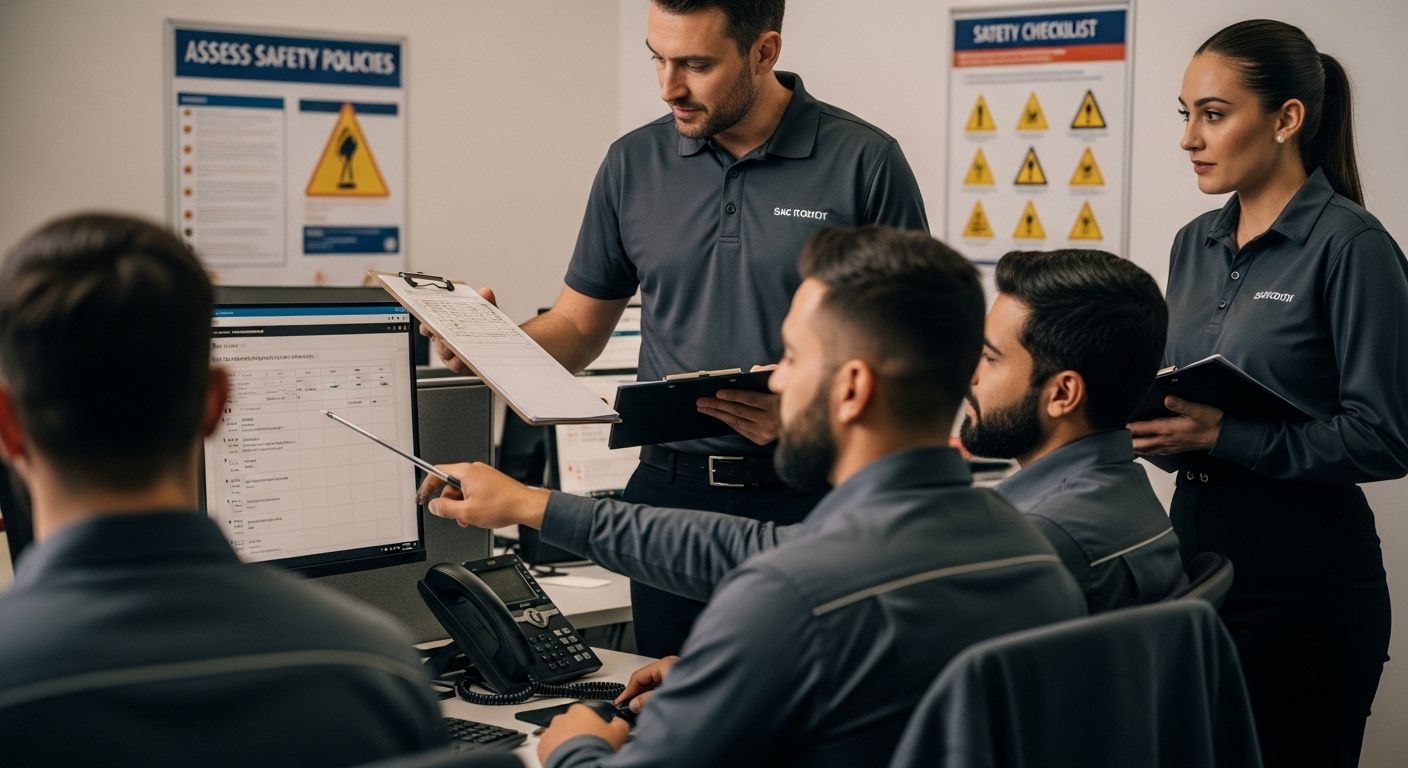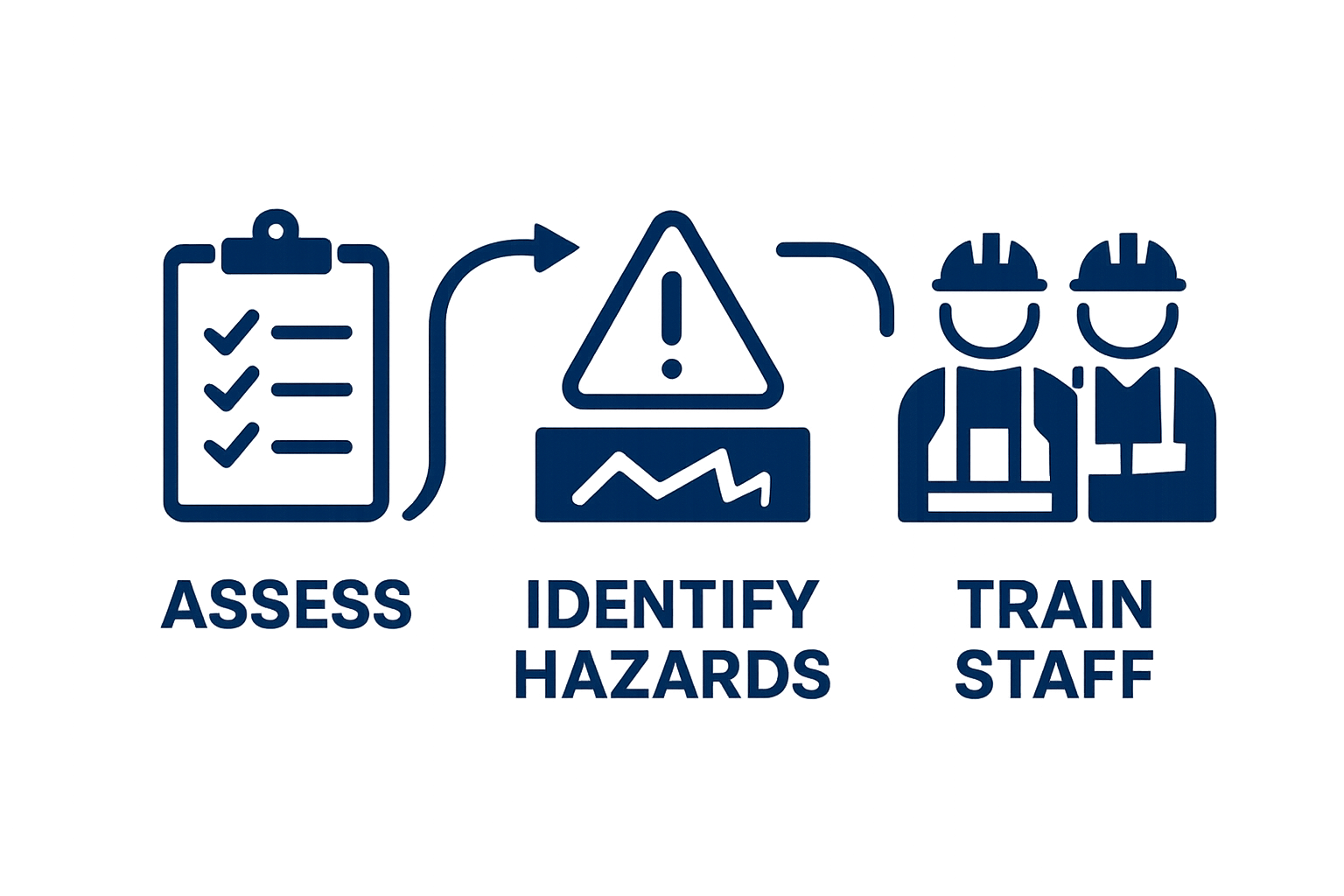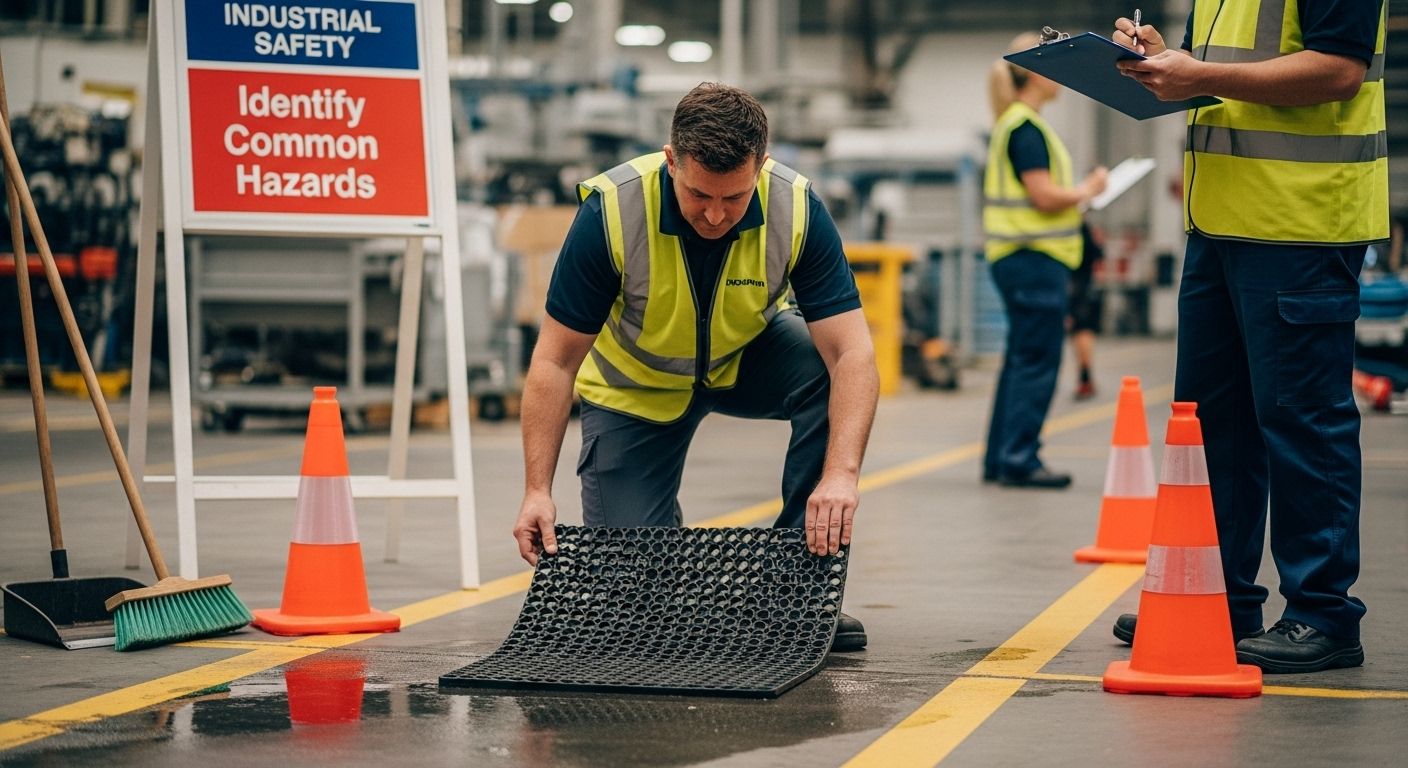
Workplace injuries are a serious issue for every business, and studies reveal that over 2.6 million nonfatal workplace injuries were reported in the US in a single year. That sounds like a huge number, right? Most people think accidents just happen out of nowhere, but the real surprise is how often the root causes hide in plain sight, easily preventable with the right steps.
Table of Contents
- Step 1: Assess Your Current Safety Policies
- Step 2: Identify Common Hazards in Your Workplace
- Step 3: Implement Training Programs for Employees
- Step 4: Establish Safety Protocols and Procedures
- Step 5: Monitor and Review Workplace Safety Regularly
Quick Summary
| Key Point | Explanation |
|---|---|
| 1. Conduct a thorough safety assessment | Evaluate current safety policies and procedures to identify risks before they escalate into serious incidents. |
| 2. Engage employees in hazard identification | Involve workers who have firsthand insights into potential workplace risks, fostering open communication about safety concerns. |
| 3. Develop tailored training programs | Create specific training that addresses the unique hazards of your workplace, ensuring employees know how to protect themselves effectively. |
| 4. Establish clear safety protocols | Set actionable guidelines for risk management that are easy to understand and accessible to all employees, enhancing compliance. |
| 5. Implement continuous monitoring and adjustments | Regularly review safety measures and protocols to adapt to new risks, ensuring a proactive approach to workplace safety. |
Step 1: Assess Your Current Safety Policies
Reducing workplace injuries begins with a comprehensive evaluation of your existing safety infrastructure. This critical first step involves a systematic review of current policies, procedures, and workplace conditions to identify potential risks before they become serious incidents.
Starting your safety assessment requires a thorough and objective examination of your workplace environment. Organizations must conduct a detailed audit that goes beyond surface level inspections. This means examining every aspect of your workplace safety protocols, from written documentation to actual implementation practices.
Begin by gathering all existing safety documentation, including employee handbooks, incident reports, training materials, and previous risk assessment records. Analyze these documents critically to understand historical patterns of workplace incidents. Look for recurring themes or specific areas where injuries have been more frequent. Our guide on trip hazard prevention can provide additional insights into identifying potential workplace risks.
Conducting a comprehensive workplace walkthrough is essential. During this inspection, document potential hazards systematically. Pay close attention to high traffic areas, equipment zones, floor conditions, and workstations. Note environmental factors such as lighting, floor surfaces, equipment placement, and potential obstacles that could contribute to workplace accidents.
Key elements to evaluate during your safety policy assessment include:
Below is a checklist table to help you systematically assess key elements when reviewing your current safety policies.
| Assessment Element | What to Check | Why It Matters |
|---|---|---|
| Safety Training Programs | Review frequency and participation | Identifies gaps in employee knowledge and highlights areas needing refresher courses |
| Incident Reporting Procedures | Examine clarity, accessibility, and follow-up actions | Ensures all incidents are documented and addressed promptly |
| PPE Requirements & Compliance | Check for clear guidelines and actual employee usage | Prevents injuries by verifying proper equipment use |
| Employee Awareness | Assess understanding of protocols through interviews or surveys | Reveals knowledge gaps and opportunities for improvement |
| Documentation Review | Gather and analyze handbooks, reports, and training records | Provides historical patterns and highlights recurring risks |
- Existing safety training programs and their frequency
- Incident reporting and investigation procedures
- Personal protective equipment (PPE) requirements and compliance
- Employee awareness and understanding of safety protocols
Engaging employees directly in this assessment process is crucial. Workers often have front line insights about potential risks that management might overlook. Create anonymous feedback mechanisms or conduct structured interviews to gather genuine perspectives about workplace safety concerns.
Successful completion of this assessment means developing a detailed report that not only identifies risks but also provides actionable recommendations for improvement. The report should include specific observations, potential hazard locations, recommended corrective actions, and a prioritized implementation plan.

Remember, a safety assessment is not a one time event but an ongoing process. Continuous monitoring, regular updates, and a commitment to proactive risk management are essential in creating a sustainable safety culture that protects your most valuable asset your employees.
Step 2: Identify Common Hazards in Your Workplace
Identifying workplace hazards is a critical step in preventing injuries and creating a safe work environment. This process involves a systematic and comprehensive examination of potential risks that could harm employees across different workplace settings. Understanding and recognizing potential dangers is the foundation of effective injury prevention.
Begin your hazard identification process by categorizing potential risks into distinct groups. Physical hazards often represent the most immediate threats, including slip and fall risks, machinery dangers, electrical complications, and environmental conditions. Learn more about effective trip hazard prevention to understand how seemingly minor obstacles can create significant workplace risks.
Conducting a comprehensive workplace walkthrough requires careful observation and strategic analysis. Walk through each area of your workplace, examining workstations, common areas, storage spaces, and equipment zones. Look beyond the obvious and consider subtle risk factors that might not be immediately apparent. Pay special attention to high traffic areas, equipment interfaces, floor conditions, and potential ergonomic challenges.
Ergonomic risks represent another crucial area of hazard identification. These risks involve physical strain, repetitive motion injuries, and workplace design issues that can cause long term health problems. Observe how employees interact with their work environments, noting awkward postures, repetitive tasks, and equipment that might require physical strain.
Key hazards to systematically evaluate include:
- Slip and trip potential in walkways and work areas
- Machinery and equipment safety risks
- Electrical and mechanical system vulnerabilities
- Ergonomic challenges in workstation design
- Chemical and environmental exposure risks
- Potential falling object or structural hazards
Engaging employees directly in the hazard identification process provides invaluable insights. Workers who perform tasks daily often recognize risks that management might overlook. Create open communication channels that encourage employees to report potential hazards without fear of retribution.
Documentation is crucial during this process. Create detailed reports that not only identify risks but also include photographic evidence, specific location details, and preliminary recommendations for mitigation.
The table below summarizes common workplace hazard categories and what to look for during hazard identification.
| Hazard Category | Examples | What to Observe |
|---|---|---|
| Physical Hazards | Slip & trip risks, equipment zones | Floor conditions, obstacles, high-traffic areas |
| Ergonomic Risks | Repetitive motions, awkward postures | Workstation setups, task movements |
| Chemical/Environmental | Exposure to chemicals, temperature extremes | Storage/handling procedures, air quality |
| Mechanical/Electrical | Machinery issues, electrical faults | Machine guarding, cords, switches |
| Falling Objects/Structural | Items stored overhead, fixtures | Storage practices, overhead clearances |

Successful hazard identification means developing a nuanced understanding of workplace risks that goes beyond surface level observations. It requires a commitment to continuous assessment, employee engagement, and proactive safety management.
Step 3: Implement Training Programs for Employees
Employee training represents the critical bridge between identifying workplace hazards and preventing potential injuries. Effective safety training transforms theoretical knowledge into practical workplace protection, empowering workers to recognize, avoid, and respond to potential risks before they become serious incidents.
Developing a comprehensive training program requires a strategic and multifaceted approach. Begin by designing curriculum that directly addresses the specific hazards identified during your workplace assessment. Training should not be a generic one size fits all solution but a targeted educational experience that speaks directly to your organization’s unique work environment. Explore our guide on understanding workplace ergonomics to gain deeper insights into creating specialized safety training modules.
Training effectiveness hinges on interactive and engaging delivery methods. Move beyond traditional lecture formats and incorporate hands on demonstrations, real world scenario simulations, and practical skill building exercises. Encourage active participant involvement through discussion groups, problem solving workshops, and collaborative learning experiences that allow employees to apply safety principles in controlled environments.
Consider implementing a multi tiered training approach that addresses different employee needs and experience levels. New employees require comprehensive initial safety orientations, while experienced workers benefit from periodic refresher courses and advanced safety technique workshops. Develop training modules that progressively build safety knowledge and reinforce critical protective behaviors.
Key components of an effective safety training program include:
Use this table as a reference for key components to cover when developing or refining your employee safety training program.
| Training Component | Focus Area | Outcome |
|---|---|---|
| Hazard Recognition | Spotting workplace hazards | Empowers staff to report and avoid risks |
| PPE Usage | Proper selection and use | Reduces likelihood of injury due to improper equipment |
| Emergency Response | Evacuation, first aid, reporting | Ensures calm, effective action in crisis situations |
| Ergonomic Practices | Safe lifting, posture, adjustments | Lowers repetitive strain and musculoskeletal injury rates |
| Workplace-Specific Strategies | Address unique risks per environment | Provides targeted, actionable guidance |
- Comprehensive hazard recognition techniques
- Proper use of personal protective equipment
- Emergency response and incident reporting procedures
- Ergonomic best practices
- Workplace specific risk mitigation strategies
Documentation plays a crucial role in training implementation. Maintain detailed records of training sessions, participant attendance, assessment results, and individual skill progression. These records not only demonstrate regulatory compliance but also provide valuable insights for continuous program improvement.
Establish a feedback mechanism that allows employees to share their perspectives on training effectiveness. Create anonymous suggestion channels, conduct post training surveys, and regularly review participant experiences. This approach ensures that your safety training remains dynamic, responsive, and aligned with evolving workplace needs.
Successful training implementation means creating a culture of safety that extends beyond formal instruction. Encourage ongoing dialogue about workplace protection, recognize employees who demonstrate exceptional safety awareness, and integrate safety conversations into daily workplace interactions. Remember that effective training is not a one time event but a continuous commitment to employee well being and organizational protection.
Step 4: Establish Safety Protocols and Procedures
Establishing comprehensive safety protocols transforms workplace safety from a reactive approach to a proactive strategy. These structured procedures serve as the blueprint for preventing workplace injuries and creating a culture of safety. By developing clear, actionable guidelines, organizations can systematically address potential risks and protect their most valuable asset their employees.
Begin by translating the hazards identified in previous assessments into specific, actionable protocols. Each protocol should provide crystal clear instructions on how to manage potential risks, including step by step procedures for handling equipment, navigating workplace environments, and responding to potential emergency situations. Check out our guide on daily cleaning checklists to understand how systematic procedures can enhance workplace safety and organization.
Developing effective safety protocols requires a collaborative approach. Engage employees from different departments and levels of the organization to ensure the protocols are practical, comprehensive, and reflective of real world workplace challenges. This collaborative process not only improves the quality of the protocols but also increases employee buy in and understanding.
Documentation is critical in establishing robust safety procedures. Create detailed written guidelines that cover every aspect of workplace safety. These documents should be comprehensive yet easily understandable, using clear language and visual aids where possible. Include specific instructions for equipment use, emergency responses, personal protective equipment requirements, and step by step risk mitigation strategies.
Critical elements to include in your safety protocols:
- Detailed emergency response procedures
- Clear equipment operation guidelines
- Personal protective equipment specifications
- Incident reporting and investigation processes
- Regular maintenance and inspection schedules
- Communication protocols for safety concerns
Implement a systematic review and update process for your safety protocols. Safety is not a static concept but a dynamic one that evolves with changing workplace environments, technologies, and potential risks. Schedule regular comprehensive reviews of your protocols, typically every six to twelve months, to ensure they remain current and effective.
Ensure accessibility and visibility of these protocols throughout the workplace. Display safety guidelines in prominent locations, distribute digital copies to all employees, and integrate them into new employee onboarding processes. Consider creating visual representations, infographics, and quick reference guides that make complex safety procedures easy to understand and follow.
Successful protocol establishment means creating a living document that grows and adapts with your organization. Encourage continuous feedback from employees, remain open to suggestions, and view safety protocols as an ongoing collaborative effort rather than a one time administrative task. By doing so, you transform safety from a compliance requirement to an integral part of your organizational culture.
Step 5: Monitor and Review Workplace Safety Regularly
Regular monitoring and review represent the critical maintenance phase of workplace safety strategies. Continuous assessment ensures that safety protocols remain effective and responsive to evolving workplace dynamics. This ongoing process transforms safety from a static set of rules into a dynamic, adaptive system that proactively protects employees.
Implement a structured monitoring approach that combines quantitative data collection with qualitative observation. Develop a comprehensive tracking system that captures incident reports, near miss experiences, employee feedback, and safety performance metrics. Explore our guide on daily cleaning checklists to understand how systematic documentation can enhance workplace safety monitoring.
Data collection should be both systematic and comprehensive. Utilize digital tracking tools that allow real time reporting and trend analysis. Create user friendly mechanisms that encourage employees to report potential safety concerns without fear of retribution. These reporting systems should be accessible, confidential, and designed to capture nuanced insights about workplace safety challenges.
Conduct regular safety audits that go beyond surface level inspections. These comprehensive reviews should involve walking through workplace environments, observing actual work practices, and comparing them against established safety protocols. Look for discrepancies between written procedures and actual implementation, identifying potential gaps that could lead to future incidents.
Key elements to monitor during safety reviews include:
- Frequency and types of workplace incidents
- Effectiveness of existing safety training programs
- Compliance with established safety protocols
- Employee adherence to personal protective equipment requirements
- Emerging workplace hazards
- Potential ergonomic challenges
Establish a cross functional safety review committee that brings together representatives from different departments. This diverse group can provide multifaceted perspectives on workplace safety, ensuring that review processes consider various operational nuances. Schedule monthly or quarterly meetings to discuss safety performance, review incident data, and develop continuous improvement strategies.
Integrate technology and data analytics into your monitoring processes. Utilize software platforms that can track safety metrics, generate comprehensive reports, and provide predictive insights about potential future risks. Advanced analytics can help identify subtle patterns that might go unnoticed through traditional monitoring methods.
Successful safety monitoring means creating a culture of continuous improvement. View each review as an opportunity to refine and enhance workplace safety strategies. Communicate review findings transparently with employees, celebrate safety achievements, and demonstrate a genuine commitment to protecting your workforce. Remember that effective monitoring is not about finding fault but about creating a safer, more responsive work environment.
Transform Your Workplace Safety With Purpose-Built Mat Solutions
You work hard to assess risks, establish strong safety protocols, and keep your team injury-free. Yet, slippery floors, high-traffic zones, and long-standing workstations can still challenge even the best safety strategies. The article highlighted the urgent need for addressing trip, slip, and ergonomic hazards—pain points most prevalent at ground level. That is where the right floor mats make a critical difference.
Mats4U.com delivers reliable protection for commercial and industrial environments. Our extensive range—including anti-fatigue, Waterhog, rubber, and custom logo mats—directly supports the steps outlined in your safety plan. With easy product selection and solutions made in the USA, you can quickly upgrade your facility. Ready to minimize hazards and boost compliance? Visit Mats4U.com to discover our safe floor mat options or start with our custom solutions for a branded professional touch. Make proactive safety a part of your workplace today—shop now and see the results in employee well-being and peace of mind.
Frequently Asked Questions
How can I assess my current safety policies at work?
Begin by conducting a thorough review of your existing safety documentation, such as employee handbooks and incident reports. Perform a workplace walkthrough to document potential hazards and gather feedback from employees about safety concerns.
What common hazards should I look for in the workplace?
Common hazards include slip and trip risks, machinery safety issues, electrical complications, ergonomic challenges, and exposure to chemicals. Conduct a detailed evaluation of workstations and high-traffic areas to identify these risks.
What key components should be included in employee safety training programs?
Employee safety training should cover hazard recognition techniques, proper use of personal protective equipment, emergency response procedures, and risk mitigation strategies tailored to the specific workplace environment.
How often should I review and update workplace safety protocols?
Workplace safety protocols should be reviewed and updated regularly, typically every six to twelve months. Continuous assessment and employee feedback are essential to ensure that safety measures remain effective and relevant.







